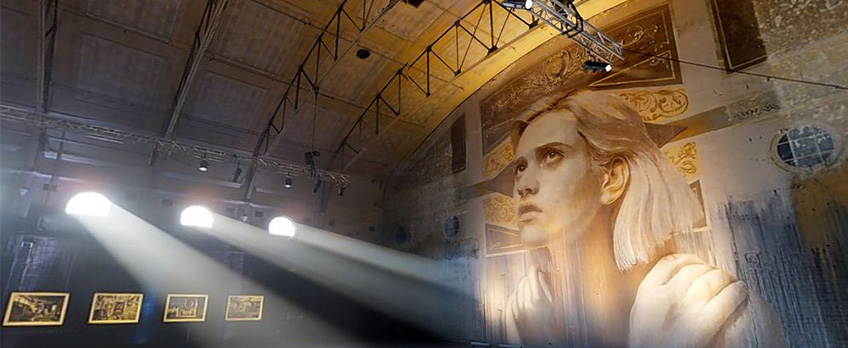Interested in writing for our blog? Send your pitches to editor@miff.com.au.
Q&A with Rone director Lester Francois

Lester Francois, the director of the VR experience Rone, answers some questions about the renowned artist's transition from street art to fine art and the challenges of making VR...
What is Rone about?
The film is a profile of street artist Rone and how in the last year his work has transitioned from street art to a fine arts practice. In between commissions around the world, Rone would seek out abandoned homes around Melbourne, break in and paint his enigmatic portraits on walls. These works would be photographed with the end result being the hugely successful Empty exhibition last year. The film also touches upon the themes of gentrification and impermanence.
Many years ago I started noticing these beautiful portraits of women's faces appearing on walls in Melbourne ... I had always found them evocative of femme fatales and there was a romantic quality to them, completely different to what else was happening on the streets.
How did you discover Rone's art? What were your drivers into creating the documentary?
I have always been a fan of street art, keenly aware when new works would be thrown up. Many years ago I started noticing these beautiful portraits of women's faces appearing on walls in Melbourne. At first they would be paste ups and stickers but soon after they were painted directly on walls. I had always found them evocative of femme fatales and there was a romantic quality to them, completely different to what else was happening on the streets.

In late 2015 I started seeing more and more of these faces in my neighbourhood and I decided I needed to unlock the mystery of who was painting them and why. After a little research I found Rone and to my surprise his studio was a ten-minute walk from my house – we live on the same street! I really wanted to explore how Rone had exploded in popularity with commissions on buildings in Melbourne around the world. How does an underground artist transition into a "legal" artist? Does he still have the urge to sneak out at night and paint illegally?
These spaces would be impossible for most people to access but through VR an audience can be transported to these abandoned buildings and stand among the ruins while gazing at Rone's work. This would be impossible to achieve in traditional mediums.
With his panting, Rone tries to bring humanity into abandoned places. When these places and the art Rone created within them disappear, does VR represent a way to bring back that humanity, to make these spaces continue to tell their stories?
One of the themes of the film is impermanence, which is part and parcel with street art. A photo of these works can only tell part of the story but through VR we get a greater context of where these works exist, what is the relationship with other works or buildings nearby. During filming in abandoned buildings I was very aware that we were preserving these beautiful paintings but also these amazing locations, which were all on the verge of collapse. These spaces would be impossible for most people to access but through VR an audience can be transported to these abandoned buildings and stand among the ruins while gazing at Rone's work. This would be impossible to achieve in traditional mediums.

What were the challenges you faced while shooting in VR?
VR provides plenty of challenges both creative and technical. There are plenty of storytelling tools I could not rely on, because they just don't work in VR. Close ups, tracking shots, hand held, etc. Because of this it was a challenge to tell a visually dynamic and engaging story, but that was part of the joy of the project – discovering a new cinematic language for this new form. There are too many technical challenges to list here! One of the unique challenges with this film though was having to break into buildings with Rone and navigate these dangerous places while lugging my VR camera. Luckily I am a one man band and did not have to take a crew in with me. That would have been impossible with most of the locations.
Rone is the first episode in the larger umbrella project, Can't Stop. Won't Stop, that aims to be a series of short VR docs about street artists.
What are the next steps for you now? Do you have more VR projects in the pipes?
Rone is the first episode in the larger umbrella project, Can't Stop. Won't Stop, that aims to be a series of short VR docs about street artists. We are about to shoot our second story and currently making an interactive VR app where these films will live. I recently pitched the project at the Sheffield Doc/Fest market, where it received a great response with multiple distribution offers. That was a huge relief after working in a vacuum for the last year.
I am also developing a few other VR projects, both live action and CG, using the Unity game engine. I definitely have the VR bug and will continue juggling both VR and traditional film.